Taxation Law: Assessable Income and Allowable Deductions
VerifiedAdded on 2023/04/24
|12
|2866
|467
AI Summary
This article discusses the concept of assessable income and allowable deductions under taxation law. It covers various sections of ITAA 1936 and ITAA 1997, and includes a case study. The article is relevant for students studying taxation law and related courses.
Contribute Materials
Your contribution can guide someone’s learning journey. Share your
documents today.
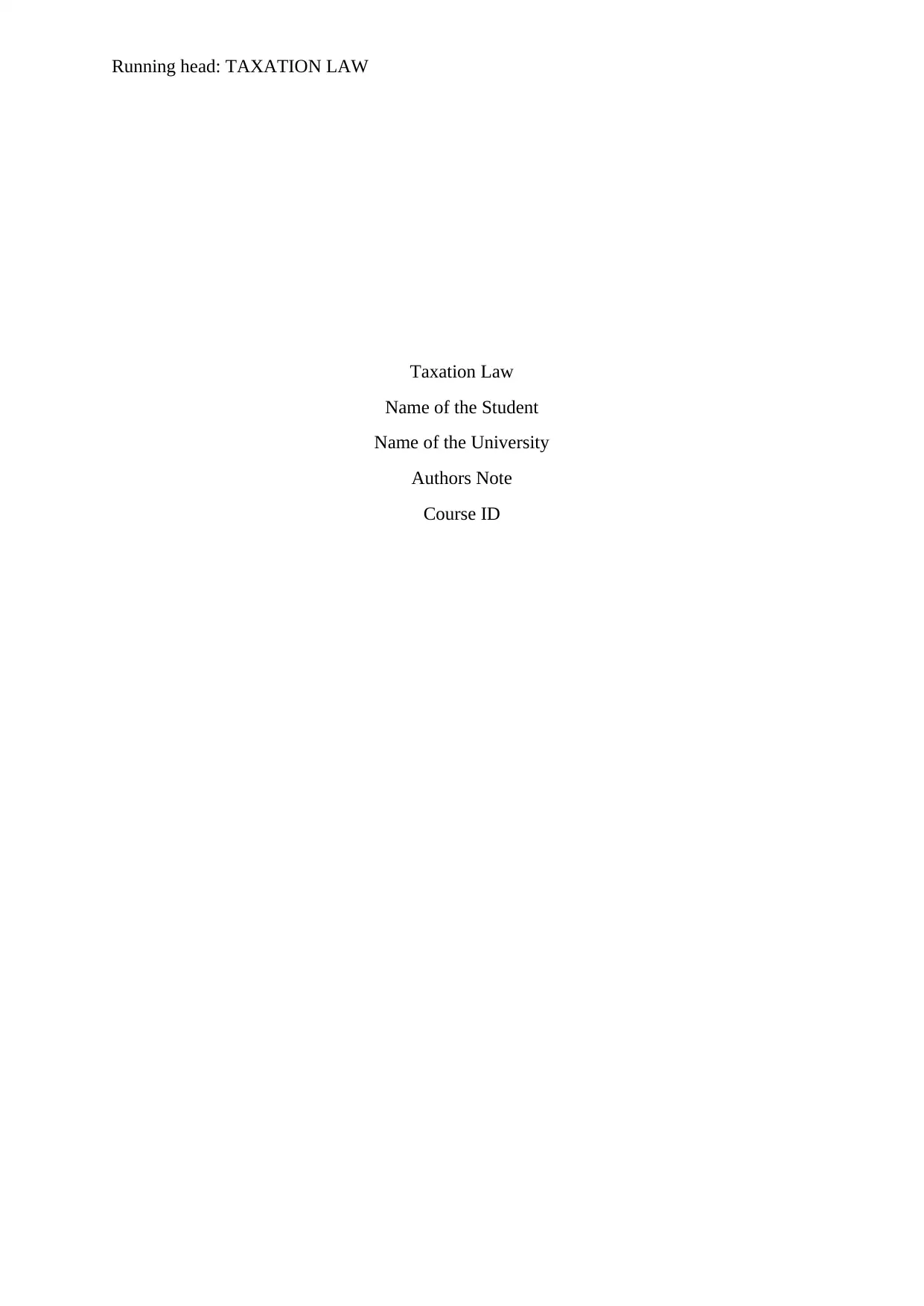
Running head: TAXATION LAW
Taxation Law
Name of the Student
Name of the University
Authors Note
Course ID
Taxation Law
Name of the Student
Name of the University
Authors Note
Course ID
Secure Best Marks with AI Grader
Need help grading? Try our AI Grader for instant feedback on your assignments.
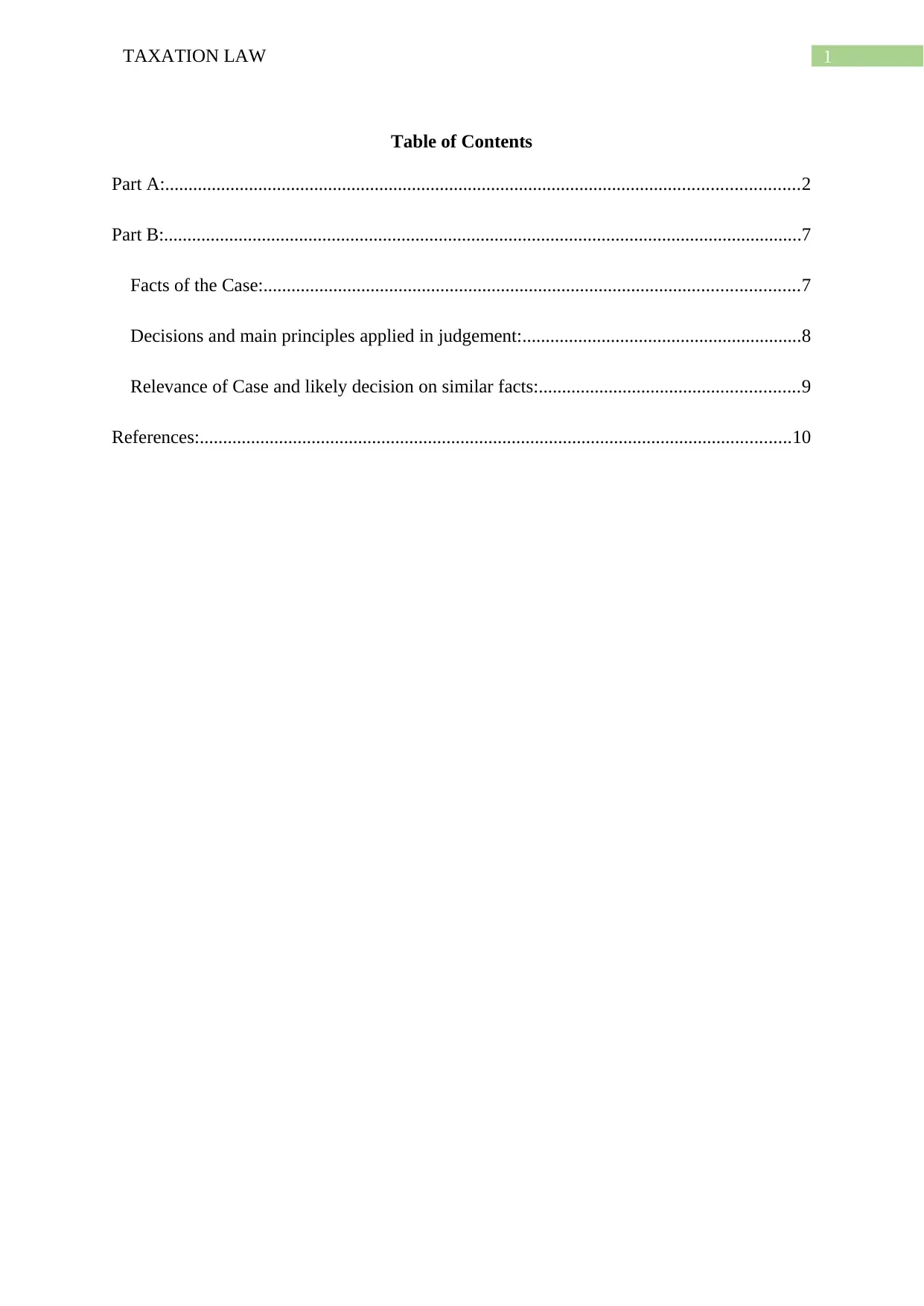
1TAXATION LAW
Table of Contents
Part A:........................................................................................................................................2
Part B:.........................................................................................................................................7
Facts of the Case:...................................................................................................................7
Decisions and main principles applied in judgement:............................................................8
Relevance of Case and likely decision on similar facts:........................................................9
References:...............................................................................................................................10
Table of Contents
Part A:........................................................................................................................................2
Part B:.........................................................................................................................................7
Facts of the Case:...................................................................................................................7
Decisions and main principles applied in judgement:............................................................8
Relevance of Case and likely decision on similar facts:........................................................9
References:...............................................................................................................................10
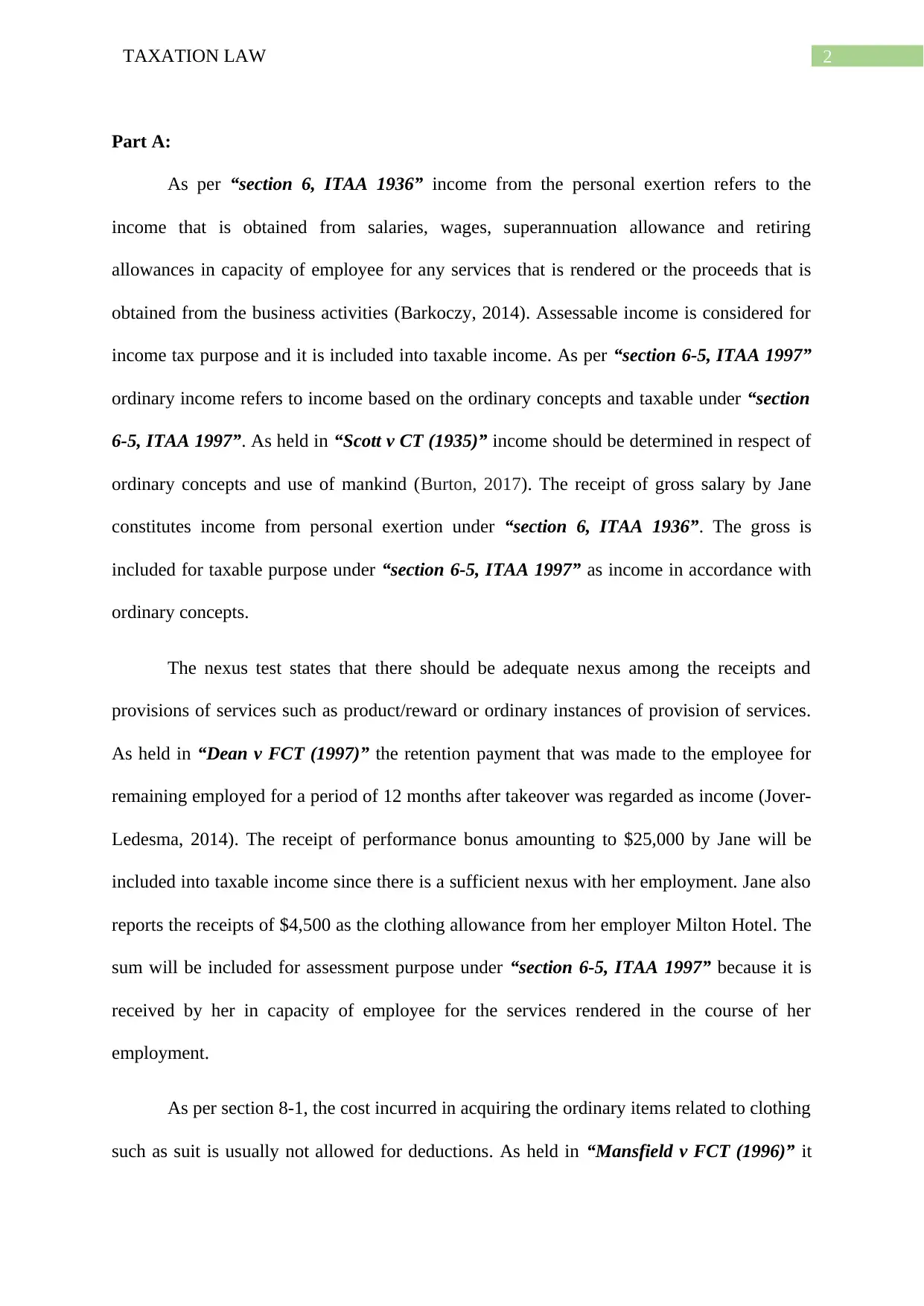
2TAXATION LAW
Part A:
As per “section 6, ITAA 1936” income from the personal exertion refers to the
income that is obtained from salaries, wages, superannuation allowance and retiring
allowances in capacity of employee for any services that is rendered or the proceeds that is
obtained from the business activities (Barkoczy, 2014). Assessable income is considered for
income tax purpose and it is included into taxable income. As per “section 6-5, ITAA 1997”
ordinary income refers to income based on the ordinary concepts and taxable under “section
6-5, ITAA 1997”. As held in “Scott v CT (1935)” income should be determined in respect of
ordinary concepts and use of mankind (Burton, 2017). The receipt of gross salary by Jane
constitutes income from personal exertion under “section 6, ITAA 1936”. The gross is
included for taxable purpose under “section 6-5, ITAA 1997” as income in accordance with
ordinary concepts.
The nexus test states that there should be adequate nexus among the receipts and
provisions of services such as product/reward or ordinary instances of provision of services.
As held in “Dean v FCT (1997)” the retention payment that was made to the employee for
remaining employed for a period of 12 months after takeover was regarded as income (Jover-
Ledesma, 2014). The receipt of performance bonus amounting to $25,000 by Jane will be
included into taxable income since there is a sufficient nexus with her employment. Jane also
reports the receipts of $4,500 as the clothing allowance from her employer Milton Hotel. The
sum will be included for assessment purpose under “section 6-5, ITAA 1997” because it is
received by her in capacity of employee for the services rendered in the course of her
employment.
As per section 8-1, the cost incurred in acquiring the ordinary items related to clothing
such as suit is usually not allowed for deductions. As held in “Mansfield v FCT (1996)” it
Part A:
As per “section 6, ITAA 1936” income from the personal exertion refers to the
income that is obtained from salaries, wages, superannuation allowance and retiring
allowances in capacity of employee for any services that is rendered or the proceeds that is
obtained from the business activities (Barkoczy, 2014). Assessable income is considered for
income tax purpose and it is included into taxable income. As per “section 6-5, ITAA 1997”
ordinary income refers to income based on the ordinary concepts and taxable under “section
6-5, ITAA 1997”. As held in “Scott v CT (1935)” income should be determined in respect of
ordinary concepts and use of mankind (Burton, 2017). The receipt of gross salary by Jane
constitutes income from personal exertion under “section 6, ITAA 1936”. The gross is
included for taxable purpose under “section 6-5, ITAA 1997” as income in accordance with
ordinary concepts.
The nexus test states that there should be adequate nexus among the receipts and
provisions of services such as product/reward or ordinary instances of provision of services.
As held in “Dean v FCT (1997)” the retention payment that was made to the employee for
remaining employed for a period of 12 months after takeover was regarded as income (Jover-
Ledesma, 2014). The receipt of performance bonus amounting to $25,000 by Jane will be
included into taxable income since there is a sufficient nexus with her employment. Jane also
reports the receipts of $4,500 as the clothing allowance from her employer Milton Hotel. The
sum will be included for assessment purpose under “section 6-5, ITAA 1997” because it is
received by her in capacity of employee for the services rendered in the course of her
employment.
As per section 8-1, the cost incurred in acquiring the ordinary items related to clothing
such as suit is usually not allowed for deductions. As held in “Mansfield v FCT (1996)” it
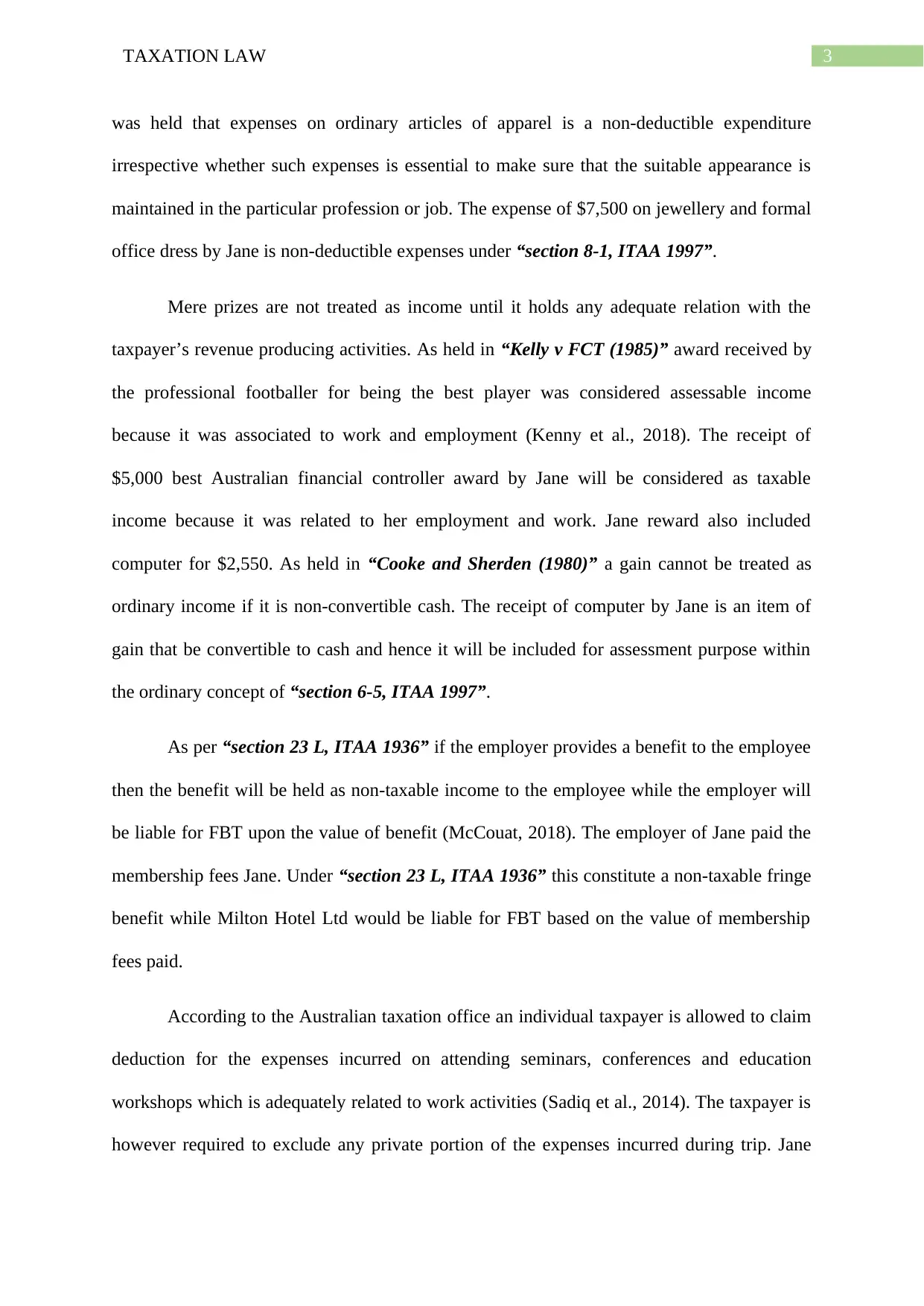
3TAXATION LAW
was held that expenses on ordinary articles of apparel is a non-deductible expenditure
irrespective whether such expenses is essential to make sure that the suitable appearance is
maintained in the particular profession or job. The expense of $7,500 on jewellery and formal
office dress by Jane is non-deductible expenses under “section 8-1, ITAA 1997”.
Mere prizes are not treated as income until it holds any adequate relation with the
taxpayer’s revenue producing activities. As held in “Kelly v FCT (1985)” award received by
the professional footballer for being the best player was considered assessable income
because it was associated to work and employment (Kenny et al., 2018). The receipt of
$5,000 best Australian financial controller award by Jane will be considered as taxable
income because it was related to her employment and work. Jane reward also included
computer for $2,550. As held in “Cooke and Sherden (1980)” a gain cannot be treated as
ordinary income if it is non-convertible cash. The receipt of computer by Jane is an item of
gain that be convertible to cash and hence it will be included for assessment purpose within
the ordinary concept of “section 6-5, ITAA 1997”.
As per “section 23 L, ITAA 1936” if the employer provides a benefit to the employee
then the benefit will be held as non-taxable income to the employee while the employer will
be liable for FBT upon the value of benefit (McCouat, 2018). The employer of Jane paid the
membership fees Jane. Under “section 23 L, ITAA 1936” this constitute a non-taxable fringe
benefit while Milton Hotel Ltd would be liable for FBT based on the value of membership
fees paid.
According to the Australian taxation office an individual taxpayer is allowed to claim
deduction for the expenses incurred on attending seminars, conferences and education
workshops which is adequately related to work activities (Sadiq et al., 2014). The taxpayer is
however required to exclude any private portion of the expenses incurred during trip. Jane
was held that expenses on ordinary articles of apparel is a non-deductible expenditure
irrespective whether such expenses is essential to make sure that the suitable appearance is
maintained in the particular profession or job. The expense of $7,500 on jewellery and formal
office dress by Jane is non-deductible expenses under “section 8-1, ITAA 1997”.
Mere prizes are not treated as income until it holds any adequate relation with the
taxpayer’s revenue producing activities. As held in “Kelly v FCT (1985)” award received by
the professional footballer for being the best player was considered assessable income
because it was associated to work and employment (Kenny et al., 2018). The receipt of
$5,000 best Australian financial controller award by Jane will be considered as taxable
income because it was related to her employment and work. Jane reward also included
computer for $2,550. As held in “Cooke and Sherden (1980)” a gain cannot be treated as
ordinary income if it is non-convertible cash. The receipt of computer by Jane is an item of
gain that be convertible to cash and hence it will be included for assessment purpose within
the ordinary concept of “section 6-5, ITAA 1997”.
As per “section 23 L, ITAA 1936” if the employer provides a benefit to the employee
then the benefit will be held as non-taxable income to the employee while the employer will
be liable for FBT upon the value of benefit (McCouat, 2018). The employer of Jane paid the
membership fees Jane. Under “section 23 L, ITAA 1936” this constitute a non-taxable fringe
benefit while Milton Hotel Ltd would be liable for FBT based on the value of membership
fees paid.
According to the Australian taxation office an individual taxpayer is allowed to claim
deduction for the expenses incurred on attending seminars, conferences and education
workshops which is adequately related to work activities (Sadiq et al., 2014). The taxpayer is
however required to exclude any private portion of the expenses incurred during trip. Jane
Secure Best Marks with AI Grader
Need help grading? Try our AI Grader for instant feedback on your assignments.
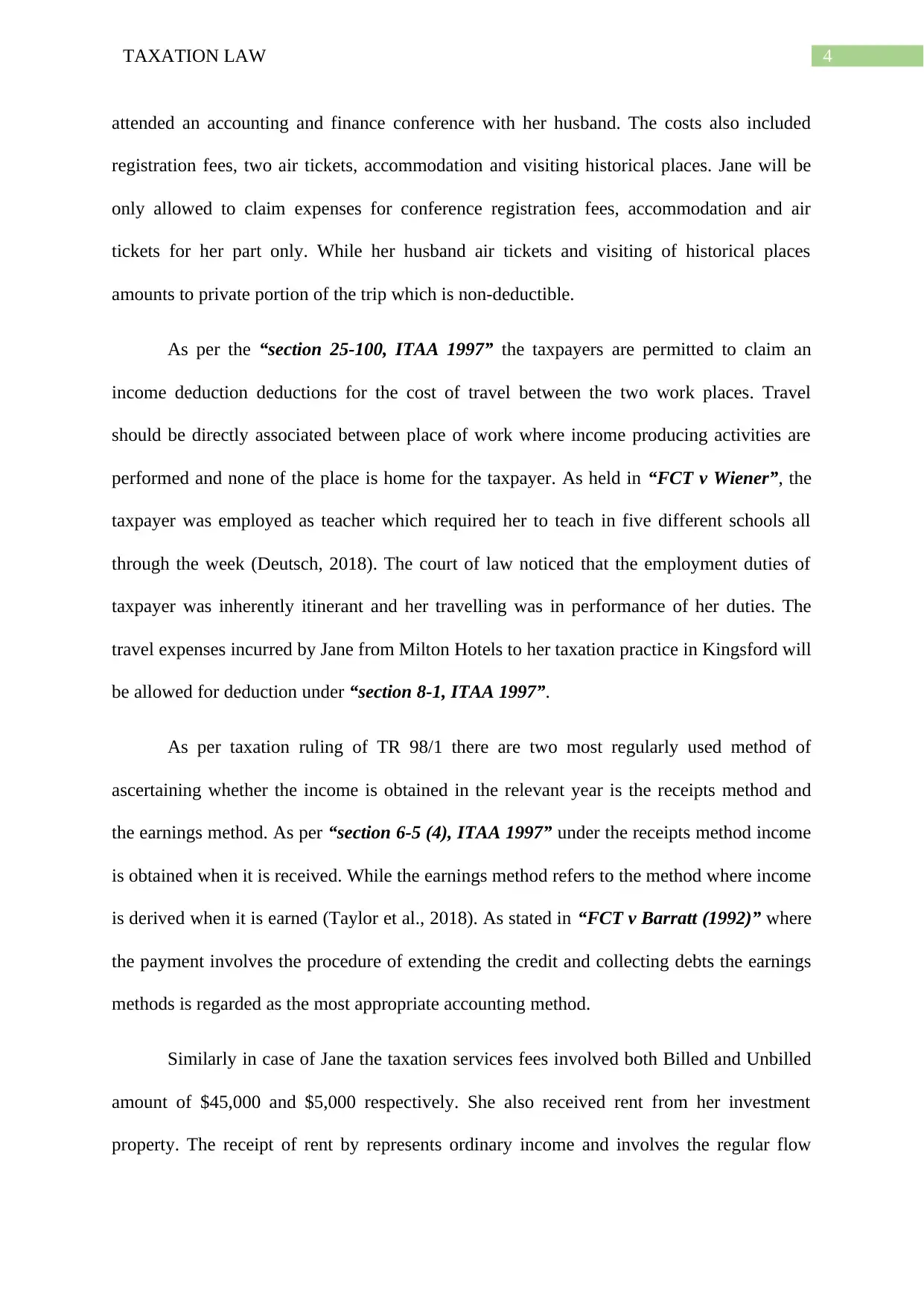
4TAXATION LAW
attended an accounting and finance conference with her husband. The costs also included
registration fees, two air tickets, accommodation and visiting historical places. Jane will be
only allowed to claim expenses for conference registration fees, accommodation and air
tickets for her part only. While her husband air tickets and visiting of historical places
amounts to private portion of the trip which is non-deductible.
As per the “section 25-100, ITAA 1997” the taxpayers are permitted to claim an
income deduction deductions for the cost of travel between the two work places. Travel
should be directly associated between place of work where income producing activities are
performed and none of the place is home for the taxpayer. As held in “FCT v Wiener”, the
taxpayer was employed as teacher which required her to teach in five different schools all
through the week (Deutsch, 2018). The court of law noticed that the employment duties of
taxpayer was inherently itinerant and her travelling was in performance of her duties. The
travel expenses incurred by Jane from Milton Hotels to her taxation practice in Kingsford will
be allowed for deduction under “section 8-1, ITAA 1997”.
As per taxation ruling of TR 98/1 there are two most regularly used method of
ascertaining whether the income is obtained in the relevant year is the receipts method and
the earnings method. As per “section 6-5 (4), ITAA 1997” under the receipts method income
is obtained when it is received. While the earnings method refers to the method where income
is derived when it is earned (Taylor et al., 2018). As stated in “FCT v Barratt (1992)” where
the payment involves the procedure of extending the credit and collecting debts the earnings
methods is regarded as the most appropriate accounting method.
Similarly in case of Jane the taxation services fees involved both Billed and Unbilled
amount of $45,000 and $5,000 respectively. She also received rent from her investment
property. The receipt of rent by represents ordinary income and involves the regular flow
attended an accounting and finance conference with her husband. The costs also included
registration fees, two air tickets, accommodation and visiting historical places. Jane will be
only allowed to claim expenses for conference registration fees, accommodation and air
tickets for her part only. While her husband air tickets and visiting of historical places
amounts to private portion of the trip which is non-deductible.
As per the “section 25-100, ITAA 1997” the taxpayers are permitted to claim an
income deduction deductions for the cost of travel between the two work places. Travel
should be directly associated between place of work where income producing activities are
performed and none of the place is home for the taxpayer. As held in “FCT v Wiener”, the
taxpayer was employed as teacher which required her to teach in five different schools all
through the week (Deutsch, 2018). The court of law noticed that the employment duties of
taxpayer was inherently itinerant and her travelling was in performance of her duties. The
travel expenses incurred by Jane from Milton Hotels to her taxation practice in Kingsford will
be allowed for deduction under “section 8-1, ITAA 1997”.
As per taxation ruling of TR 98/1 there are two most regularly used method of
ascertaining whether the income is obtained in the relevant year is the receipts method and
the earnings method. As per “section 6-5 (4), ITAA 1997” under the receipts method income
is obtained when it is received. While the earnings method refers to the method where income
is derived when it is earned (Taylor et al., 2018). As stated in “FCT v Barratt (1992)” where
the payment involves the procedure of extending the credit and collecting debts the earnings
methods is regarded as the most appropriate accounting method.
Similarly in case of Jane the taxation services fees involved both Billed and Unbilled
amount of $45,000 and $5,000 respectively. She also received rent from her investment
property. The receipt of rent by represents ordinary income and involves the regular flow

5TAXATION LAW
concept from the rental property. Citing “FCT v Barratt (1992)” for the purpose of taxation a
substantially right reflex of Jane’s business and rental income can be provided by using the
earnings method. The taxation fees services and the rental property income is included for
assessment based on earnings method since the income was derived by Jane when it was
earned (Woellner et al., 2018). The point of derivation occurred for Jane both in case of her
taxation practice business and rental investment property when the recoverable debt was
created for the unbilled and accrued amount of taxation fees and rent respectively.
The expenses incurred in relation to her taxation practice business and investment
property is considered as allowable deduction under “section 8-1, ITAA 1997”. The expenses
were incurred during the course of producing assessable income.
On the basis of “section 44 (1) of the ITAA 1936”, dividends received by Jane are
included for assessment as the statutory income while the franking credits associated with
dividends are taxable under “section 207-20(1), ITAA 1997” (Miller & Oats, 2016). The
receipts of dividends and franking credits by Jane are included for assessment as statutory
income.
During the year Jane reported capital gains from the sale of CBA shares. Citing “FCT
v McNeil” the gains from CBA shares are included as ordinary income for assessment. While
the gains from BHP shares yielded loss (Mellon, 2016). The capital loss made from sale of
BHP shares can be offset by Jane against the capital gains made from CBA shares. The
donations made to Cancer Council Australia and Sydney University are deductible gifts
recipient and hence Jane is allowed to claim deduction for these expenses.
concept from the rental property. Citing “FCT v Barratt (1992)” for the purpose of taxation a
substantially right reflex of Jane’s business and rental income can be provided by using the
earnings method. The taxation fees services and the rental property income is included for
assessment based on earnings method since the income was derived by Jane when it was
earned (Woellner et al., 2018). The point of derivation occurred for Jane both in case of her
taxation practice business and rental investment property when the recoverable debt was
created for the unbilled and accrued amount of taxation fees and rent respectively.
The expenses incurred in relation to her taxation practice business and investment
property is considered as allowable deduction under “section 8-1, ITAA 1997”. The expenses
were incurred during the course of producing assessable income.
On the basis of “section 44 (1) of the ITAA 1936”, dividends received by Jane are
included for assessment as the statutory income while the franking credits associated with
dividends are taxable under “section 207-20(1), ITAA 1997” (Miller & Oats, 2016). The
receipts of dividends and franking credits by Jane are included for assessment as statutory
income.
During the year Jane reported capital gains from the sale of CBA shares. Citing “FCT
v McNeil” the gains from CBA shares are included as ordinary income for assessment. While
the gains from BHP shares yielded loss (Mellon, 2016). The capital loss made from sale of
BHP shares can be offset by Jane against the capital gains made from CBA shares. The
donations made to Cancer Council Australia and Sydney University are deductible gifts
recipient and hence Jane is allowed to claim deduction for these expenses.
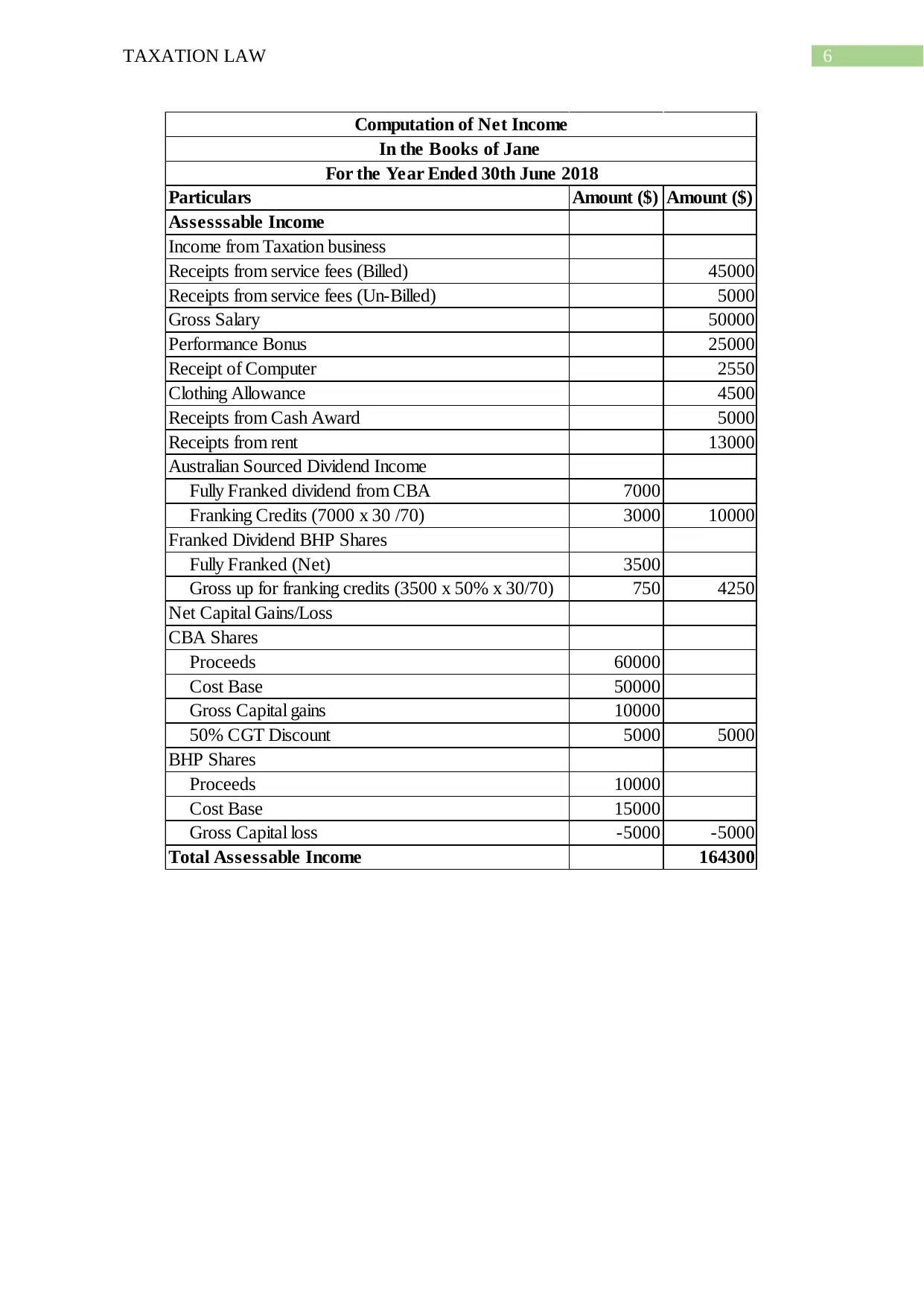
6TAXATION LAW
Particulars Amount ($) Amount ($)
Assesssable Income
Income from Taxation business
Receipts from service fees (Billed) 45000
Receipts from service fees (Un-Billed) 5000
Gross Salary 50000
Performance Bonus 25000
Receipt of Computer 2550
Clothing Allowance 4500
Receipts from Cash Award 5000
Receipts from rent 13000
Australian Sourced Dividend Income
Fully Franked dividend from CBA 7000
Franking Credits (7000 x 30 /70) 3000 10000
Franked Dividend BHP Shares
Fully Franked (Net) 3500
Gross up for franking credits (3500 x 50% x 30/70) 750 4250
Net Capital Gains/Loss
CBA Shares
Proceeds 60000
Cost Base 50000
Gross Capital gains 10000
50% CGT Discount 5000 5000
BHP Shares
Proceeds 10000
Cost Base 15000
Gross Capital loss -5000 -5000
Total Assessable Income 164300
Computation of Net Income
In the Books of Jane
For the Year Ended 30th June 2018
Particulars Amount ($) Amount ($)
Assesssable Income
Income from Taxation business
Receipts from service fees (Billed) 45000
Receipts from service fees (Un-Billed) 5000
Gross Salary 50000
Performance Bonus 25000
Receipt of Computer 2550
Clothing Allowance 4500
Receipts from Cash Award 5000
Receipts from rent 13000
Australian Sourced Dividend Income
Fully Franked dividend from CBA 7000
Franking Credits (7000 x 30 /70) 3000 10000
Franked Dividend BHP Shares
Fully Franked (Net) 3500
Gross up for franking credits (3500 x 50% x 30/70) 750 4250
Net Capital Gains/Loss
CBA Shares
Proceeds 60000
Cost Base 50000
Gross Capital gains 10000
50% CGT Discount 5000 5000
BHP Shares
Proceeds 10000
Cost Base 15000
Gross Capital loss -5000 -5000
Total Assessable Income 164300
Computation of Net Income
In the Books of Jane
For the Year Ended 30th June 2018
Paraphrase This Document
Need a fresh take? Get an instant paraphrase of this document with our AI Paraphraser

7TAXATION LAW
Allowable Deductions
Salary to Secretary 26000
Telephone and internet 1200
Entertainment Expenses 1250
Travel Expenses - Business 450
Motor Vehicle Runnng Expenses 2600
Purchase of Car for Business purpose 60823
Registration Fees for Conference 500
Air ticket (Excluding husband) 400
Hotel Accomodations 850
Taxi Expenses 4000
Council rates 1200
Cleaning expenses 650
Insurance 450
Property agent commission 625
Repairs and maintenance 1250
Water rates 1240
Travel Expenses - Rental 450
Donation to Cancer Council Australia 1500
University in Sydney 2000
Total Allowable Deductions 107438
Total Taxable Income 56862
Tax on Taxable Income 10027.15
Add: Medicare Levy 2148.758
Less: PayG 3250
Less: Franking Credits 3750
Total Tax Payable 5175.91
Part B:
Facts of the Case:
In the case of “FCT v Cooke and Sherden, (1980)” the husband and wife were the
partners and carried on the business by separately visiting door-to-door distribution of soft
drinks under the agreement of franchise with the soft drink manufacturers (Bankman et al.,
2018). The manufacturers sponsored incentive schemes which allowed their distributors to
each win either local or overseas holiday trips. The trips were non-transferable and non-
convertible to cash. If the winners did not wish to take trip then they were not provided any
Allowable Deductions
Salary to Secretary 26000
Telephone and internet 1200
Entertainment Expenses 1250
Travel Expenses - Business 450
Motor Vehicle Runnng Expenses 2600
Purchase of Car for Business purpose 60823
Registration Fees for Conference 500
Air ticket (Excluding husband) 400
Hotel Accomodations 850
Taxi Expenses 4000
Council rates 1200
Cleaning expenses 650
Insurance 450
Property agent commission 625
Repairs and maintenance 1250
Water rates 1240
Travel Expenses - Rental 450
Donation to Cancer Council Australia 1500
University in Sydney 2000
Total Allowable Deductions 107438
Total Taxable Income 56862
Tax on Taxable Income 10027.15
Add: Medicare Levy 2148.758
Less: PayG 3250
Less: Franking Credits 3750
Total Tax Payable 5175.91
Part B:
Facts of the Case:
In the case of “FCT v Cooke and Sherden, (1980)” the husband and wife were the
partners and carried on the business by separately visiting door-to-door distribution of soft
drinks under the agreement of franchise with the soft drink manufacturers (Bankman et al.,
2018). The manufacturers sponsored incentive schemes which allowed their distributors to
each win either local or overseas holiday trips. The trips were non-transferable and non-
convertible to cash. If the winners did not wish to take trip then they were not provided any
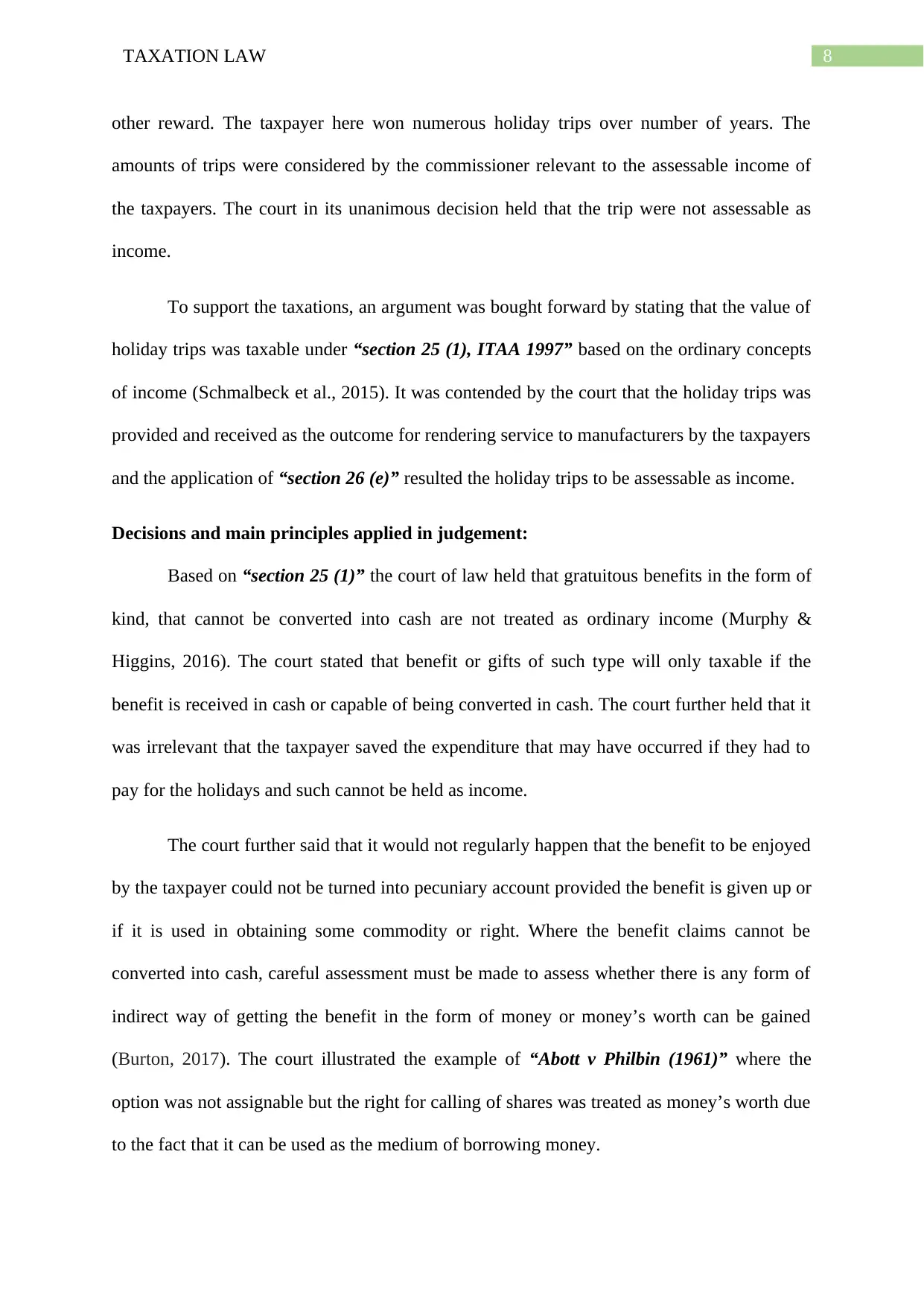
8TAXATION LAW
other reward. The taxpayer here won numerous holiday trips over number of years. The
amounts of trips were considered by the commissioner relevant to the assessable income of
the taxpayers. The court in its unanimous decision held that the trip were not assessable as
income.
To support the taxations, an argument was bought forward by stating that the value of
holiday trips was taxable under “section 25 (1), ITAA 1997” based on the ordinary concepts
of income (Schmalbeck et al., 2015). It was contended by the court that the holiday trips was
provided and received as the outcome for rendering service to manufacturers by the taxpayers
and the application of “section 26 (e)” resulted the holiday trips to be assessable as income.
Decisions and main principles applied in judgement:
Based on “section 25 (1)” the court of law held that gratuitous benefits in the form of
kind, that cannot be converted into cash are not treated as ordinary income (Murphy &
Higgins, 2016). The court stated that benefit or gifts of such type will only taxable if the
benefit is received in cash or capable of being converted in cash. The court further held that it
was irrelevant that the taxpayer saved the expenditure that may have occurred if they had to
pay for the holidays and such cannot be held as income.
The court further said that it would not regularly happen that the benefit to be enjoyed
by the taxpayer could not be turned into pecuniary account provided the benefit is given up or
if it is used in obtaining some commodity or right. Where the benefit claims cannot be
converted into cash, careful assessment must be made to assess whether there is any form of
indirect way of getting the benefit in the form of money or money’s worth can be gained
(Burton, 2017). The court illustrated the example of “Abott v Philbin (1961)” where the
option was not assignable but the right for calling of shares was treated as money’s worth due
to the fact that it can be used as the medium of borrowing money.
other reward. The taxpayer here won numerous holiday trips over number of years. The
amounts of trips were considered by the commissioner relevant to the assessable income of
the taxpayers. The court in its unanimous decision held that the trip were not assessable as
income.
To support the taxations, an argument was bought forward by stating that the value of
holiday trips was taxable under “section 25 (1), ITAA 1997” based on the ordinary concepts
of income (Schmalbeck et al., 2015). It was contended by the court that the holiday trips was
provided and received as the outcome for rendering service to manufacturers by the taxpayers
and the application of “section 26 (e)” resulted the holiday trips to be assessable as income.
Decisions and main principles applied in judgement:
Based on “section 25 (1)” the court of law held that gratuitous benefits in the form of
kind, that cannot be converted into cash are not treated as ordinary income (Murphy &
Higgins, 2016). The court stated that benefit or gifts of such type will only taxable if the
benefit is received in cash or capable of being converted in cash. The court further held that it
was irrelevant that the taxpayer saved the expenditure that may have occurred if they had to
pay for the holidays and such cannot be held as income.
The court further said that it would not regularly happen that the benefit to be enjoyed
by the taxpayer could not be turned into pecuniary account provided the benefit is given up or
if it is used in obtaining some commodity or right. Where the benefit claims cannot be
converted into cash, careful assessment must be made to assess whether there is any form of
indirect way of getting the benefit in the form of money or money’s worth can be gained
(Burton, 2017). The court illustrated the example of “Abott v Philbin (1961)” where the
option was not assignable but the right for calling of shares was treated as money’s worth due
to the fact that it can be used as the medium of borrowing money.
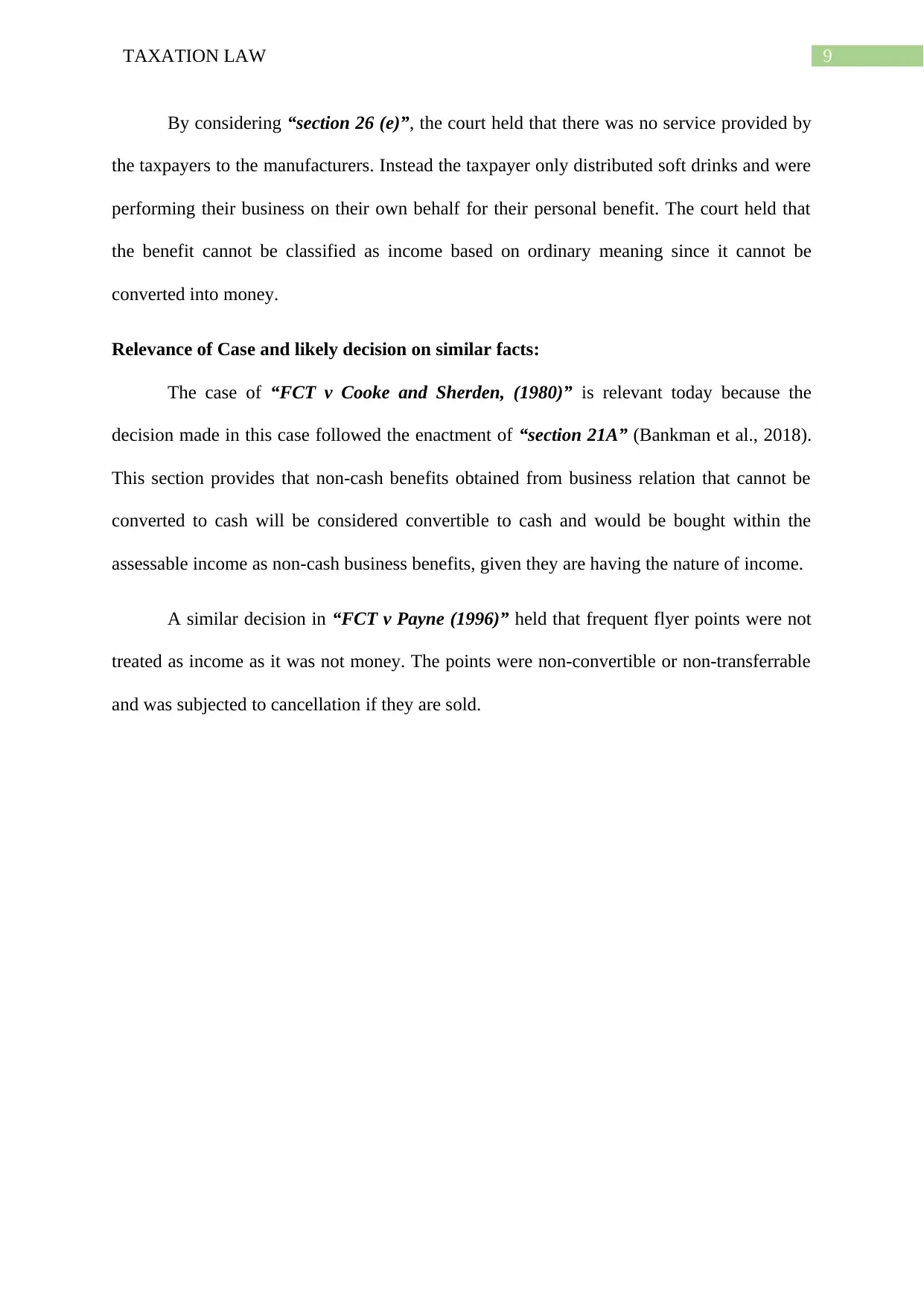
9TAXATION LAW
By considering “section 26 (e)”, the court held that there was no service provided by
the taxpayers to the manufacturers. Instead the taxpayer only distributed soft drinks and were
performing their business on their own behalf for their personal benefit. The court held that
the benefit cannot be classified as income based on ordinary meaning since it cannot be
converted into money.
Relevance of Case and likely decision on similar facts:
The case of “FCT v Cooke and Sherden, (1980)” is relevant today because the
decision made in this case followed the enactment of “section 21A” (Bankman et al., 2018).
This section provides that non-cash benefits obtained from business relation that cannot be
converted to cash will be considered convertible to cash and would be bought within the
assessable income as non-cash business benefits, given they are having the nature of income.
A similar decision in “FCT v Payne (1996)” held that frequent flyer points were not
treated as income as it was not money. The points were non-convertible or non-transferrable
and was subjected to cancellation if they are sold.
By considering “section 26 (e)”, the court held that there was no service provided by
the taxpayers to the manufacturers. Instead the taxpayer only distributed soft drinks and were
performing their business on their own behalf for their personal benefit. The court held that
the benefit cannot be classified as income based on ordinary meaning since it cannot be
converted into money.
Relevance of Case and likely decision on similar facts:
The case of “FCT v Cooke and Sherden, (1980)” is relevant today because the
decision made in this case followed the enactment of “section 21A” (Bankman et al., 2018).
This section provides that non-cash benefits obtained from business relation that cannot be
converted to cash will be considered convertible to cash and would be bought within the
assessable income as non-cash business benefits, given they are having the nature of income.
A similar decision in “FCT v Payne (1996)” held that frequent flyer points were not
treated as income as it was not money. The points were non-convertible or non-transferrable
and was subjected to cancellation if they are sold.
Secure Best Marks with AI Grader
Need help grading? Try our AI Grader for instant feedback on your assignments.
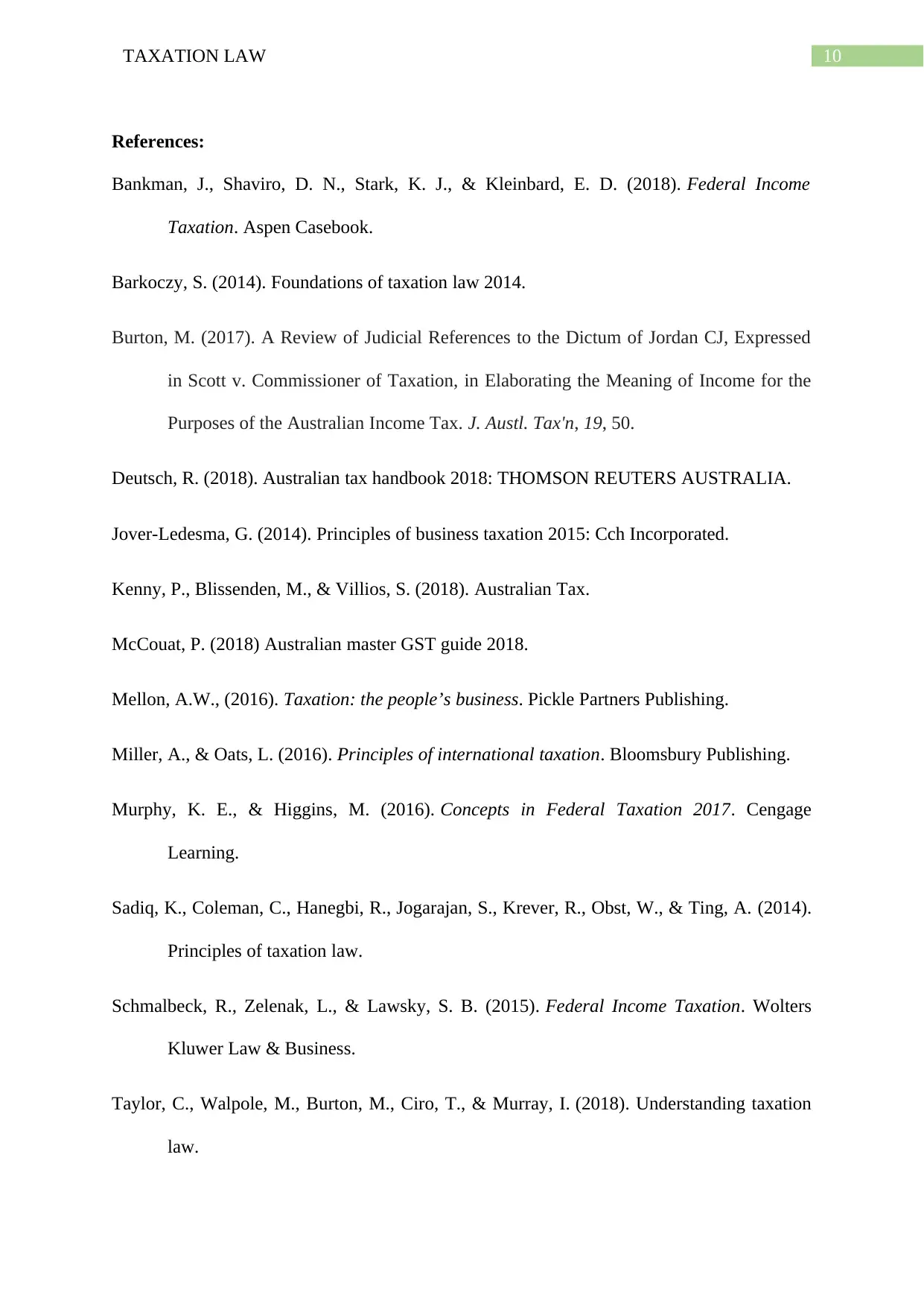
10TAXATION LAW
References:
Bankman, J., Shaviro, D. N., Stark, K. J., & Kleinbard, E. D. (2018). Federal Income
Taxation. Aspen Casebook.
Barkoczy, S. (2014). Foundations of taxation law 2014.
Burton, M. (2017). A Review of Judicial References to the Dictum of Jordan CJ, Expressed
in Scott v. Commissioner of Taxation, in Elaborating the Meaning of Income for the
Purposes of the Australian Income Tax. J. Austl. Tax'n, 19, 50.
Deutsch, R. (2018). Australian tax handbook 2018: THOMSON REUTERS AUSTRALIA.
Jover-Ledesma, G. (2014). Principles of business taxation 2015: Cch Incorporated.
Kenny, P., Blissenden, M., & Villios, S. (2018). Australian Tax.
McCouat, P. (2018) Australian master GST guide 2018.
Mellon, A.W., (2016). Taxation: the people’s business. Pickle Partners Publishing.
Miller, A., & Oats, L. (2016). Principles of international taxation. Bloomsbury Publishing.
Murphy, K. E., & Higgins, M. (2016). Concepts in Federal Taxation 2017. Cengage
Learning.
Sadiq, K., Coleman, C., Hanegbi, R., Jogarajan, S., Krever, R., Obst, W., & Ting, A. (2014).
Principles of taxation law.
Schmalbeck, R., Zelenak, L., & Lawsky, S. B. (2015). Federal Income Taxation. Wolters
Kluwer Law & Business.
Taylor, C., Walpole, M., Burton, M., Ciro, T., & Murray, I. (2018). Understanding taxation
law.
References:
Bankman, J., Shaviro, D. N., Stark, K. J., & Kleinbard, E. D. (2018). Federal Income
Taxation. Aspen Casebook.
Barkoczy, S. (2014). Foundations of taxation law 2014.
Burton, M. (2017). A Review of Judicial References to the Dictum of Jordan CJ, Expressed
in Scott v. Commissioner of Taxation, in Elaborating the Meaning of Income for the
Purposes of the Australian Income Tax. J. Austl. Tax'n, 19, 50.
Deutsch, R. (2018). Australian tax handbook 2018: THOMSON REUTERS AUSTRALIA.
Jover-Ledesma, G. (2014). Principles of business taxation 2015: Cch Incorporated.
Kenny, P., Blissenden, M., & Villios, S. (2018). Australian Tax.
McCouat, P. (2018) Australian master GST guide 2018.
Mellon, A.W., (2016). Taxation: the people’s business. Pickle Partners Publishing.
Miller, A., & Oats, L. (2016). Principles of international taxation. Bloomsbury Publishing.
Murphy, K. E., & Higgins, M. (2016). Concepts in Federal Taxation 2017. Cengage
Learning.
Sadiq, K., Coleman, C., Hanegbi, R., Jogarajan, S., Krever, R., Obst, W., & Ting, A. (2014).
Principles of taxation law.
Schmalbeck, R., Zelenak, L., & Lawsky, S. B. (2015). Federal Income Taxation. Wolters
Kluwer Law & Business.
Taylor, C., Walpole, M., Burton, M., Ciro, T., & Murray, I. (2018). Understanding taxation
law.
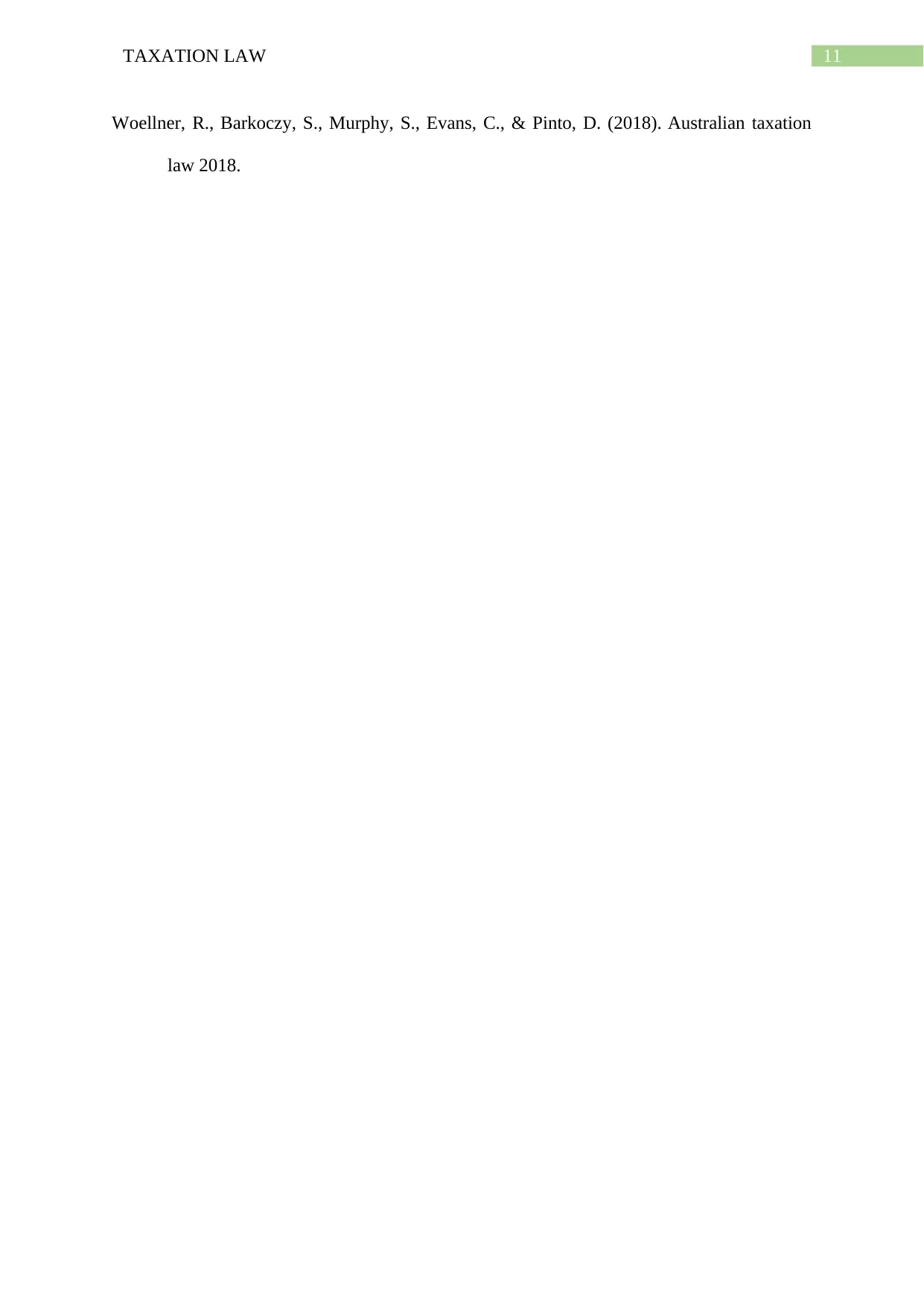
11TAXATION LAW
Woellner, R., Barkoczy, S., Murphy, S., Evans, C., & Pinto, D. (2018). Australian taxation
law 2018.
Woellner, R., Barkoczy, S., Murphy, S., Evans, C., & Pinto, D. (2018). Australian taxation
law 2018.
1 out of 12
Related Documents
Your All-in-One AI-Powered Toolkit for Academic Success.
+13062052269
info@desklib.com
Available 24*7 on WhatsApp / Email
![[object Object]](/_next/static/media/star-bottom.7253800d.svg)
Unlock your academic potential
© 2024 | Zucol Services PVT LTD | All rights reserved.





